display TOYOTA RAV4 PLUG-IN HYBRID 2023 Owners Manual
[x] Cancel search | Manufacturer: TOYOTA, Model Year: 2023, Model line: RAV4 PLUG-IN HYBRID, Model: TOYOTA RAV4 PLUG-IN HYBRID 2023Pages: 718, PDF Size: 167.55 MB
Page 230 of 718
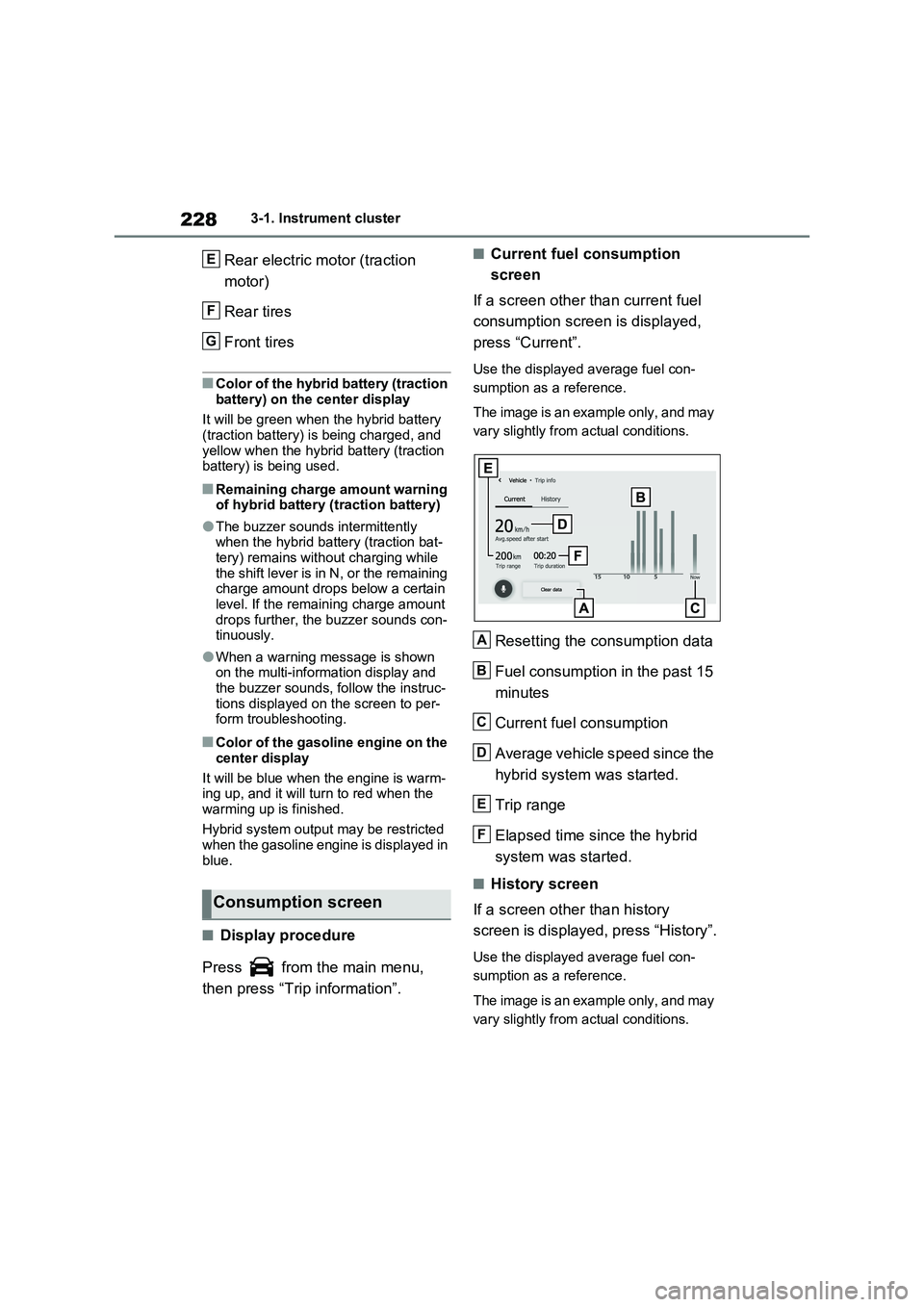
2283-1. Instrument cluster
Rear electric motor (traction
motor)
Rear tires
Front tires
■Color of the hybrid battery (traction
battery) on the center display
It will be green when the hybrid battery
(traction battery) is being charged, and
yellow when the hybrid battery (traction
battery) is being used.
■Remaining charge amount warning
of hybrid battery (traction battery)
●The buzzer sounds intermittently
when the hybrid battery (traction bat-
tery) remains without charging while
the shift lever is in N, or the remaining
charge amount drops below a certain
level. If the remaining charge amount
drops further, the buzzer sounds con-
tinuously.
●When a warning message is shown
on the multi-information display and
the buzzer sounds, follow the instruc-
tions displayed on the screen to per-
form troubleshooting.
■Color of the gasoline engine on the
center display
It will be blue when the engine is warm-
ing up, and it will turn to red when the
warming up is finished.
Hybrid system output may be restricted
when the gasoline engine is displayed in
blue.
■Display procedure
Press from the main menu,
then press “Trip information”.
■Current fuel consumption
screen
If a screen other than current fuel
consumption screen is displayed,
press “Current”.
Use the displayed average fuel con-
sumption as a reference.
The image is an example only, and may
vary slightly from actual conditions.
Resetting the consumption data
Fuel consumption in the past 15
minutes
Current fuel consumption
Average vehicle speed since the
hybrid system was started.
Trip range
Elapsed time since the hybrid
system was started.
■History screen
If a screen other than history
screen is displayed, press “History”.
Use the displayed average fuel con-
sumption as a reference.
The image is an example only, and may
vary slightly from actual conditions.
Consumption screen
E
F
G
A
B
C
D
E
F
Page 231 of 718
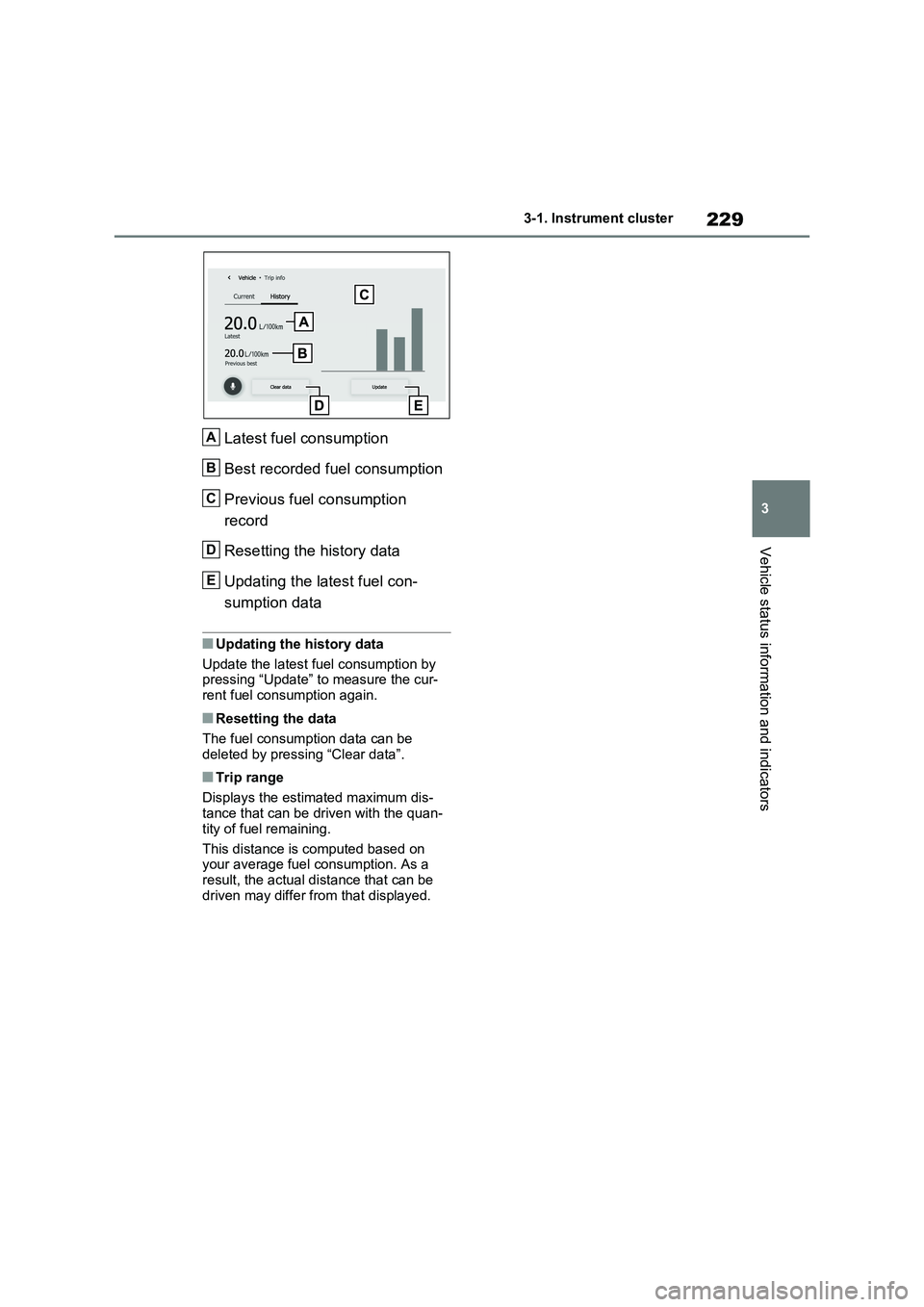
229
3 3-1. Instrument cluster
Vehicle status information and indicators
Latest fuel consumption
Best recorded fuel consumption
Previous fuel consumption
record
Resetting the history data
Updating the latest fuel con-
sumption data
■Updating the history data
Update the latest fuel consumption by
pressing “Update” to measure the cur-
rent fuel consumption again.
■Resetting the data
The fuel consumption data can be
deleted by pressing “Clear data”.
■Trip range
Displays the estimated maximum dis-
tance that can be driven with the quan-
tity of fuel remaining.
This distance is computed based on
your average fuel consumption. As a
result, the actual distance that can be
driven may differ from that displayed.
A
B
C
D
E
Page 234 of 718
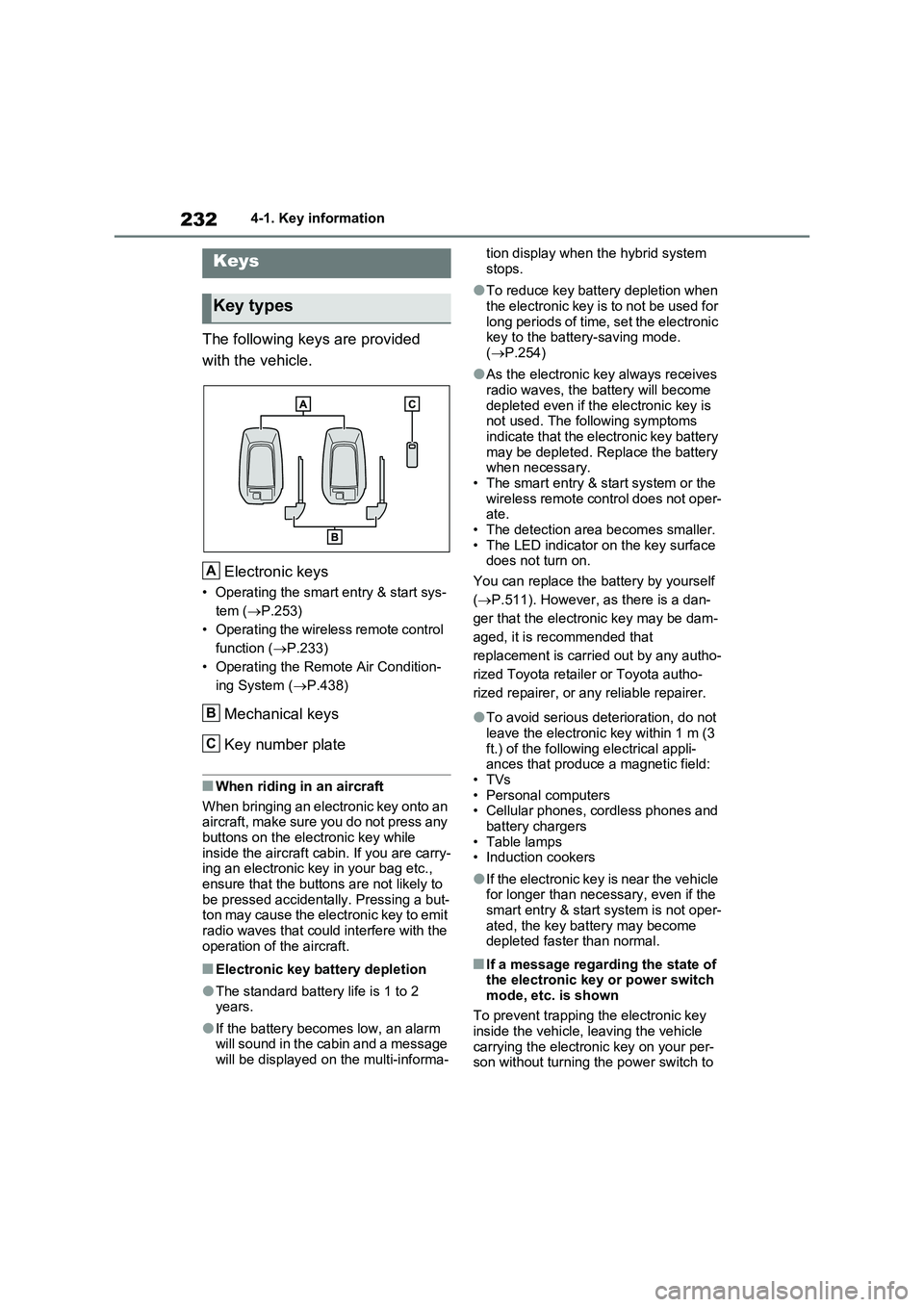
2324-1. Key information
4-1.Key info rmation
The following keys are provided
with the vehicle.
Electronic keys
• Operating the smart entry & start sys-
tem ( P.253)
• Operating the wireless remote control
function ( P.233)
• Operating the Remote Air Condition-
ing System ( P.438)
Mechanical keys
Key number plate
■When riding in an aircraft
When bringing an electronic key onto an aircraft, make sure you do not press any
buttons on the electronic key while inside the aircraft cabin. If you are carry-ing an electronic key in your bag etc.,
ensure that the buttons are not likely to be pressed accidentally. Pressing a but-ton may cause the electronic key to emit
radio waves that could interfere with the operation of the aircraft.
■Electronic key battery depletion
●The standard battery life is 1 to 2 years.
●If the battery becomes low, an alarm will sound in the cabin and a message will be displayed on the multi-informa-
tion display when the hybrid system
stops.
●To reduce key battery depletion when
the electronic key is to not be used for long periods of time, set the electronic key to the battery-saving mode.
( P.254)
●As the electronic key always receives
radio waves, the battery will become depleted even if the electronic key is not used. The following symptoms
indicate that the electronic key battery may be depleted. Replace the battery when necessary.
• The smart entry & start system or the wireless remote control does not oper-ate.
• The detection area becomes smaller. • The LED indicator on the key surface does not turn on.
You can replace the battery by yourself
( P.511). However, as there is a dan-
ger that the electronic key may be dam-
aged, it is recommended that
replacement is carried out by any autho-
rized Toyota retailer or Toyota autho-
rized repairer, or any reliable repairer.
●To avoid serious deterioration, do not leave the electronic key within 1 m (3
ft.) of the following electrical appli- ances that produce a magnetic field:•TVs
• Personal computers • Cellular phones, cordless phones and battery chargers
•Table lamps • Induction cookers
●If the electronic key is near the vehicle for longer than necessary, even if the smart entry & start system is not oper-
ated, the key battery may become depleted faster than normal.
■If a message regarding the state of the electronic key or power switch
mode, etc. is shown
To prevent trapping the electronic key inside the vehicle, leaving the vehicle
carrying the electronic key on your per- son without turning the power switch to
Keys
Key types
A
B
C
Page 235 of 718
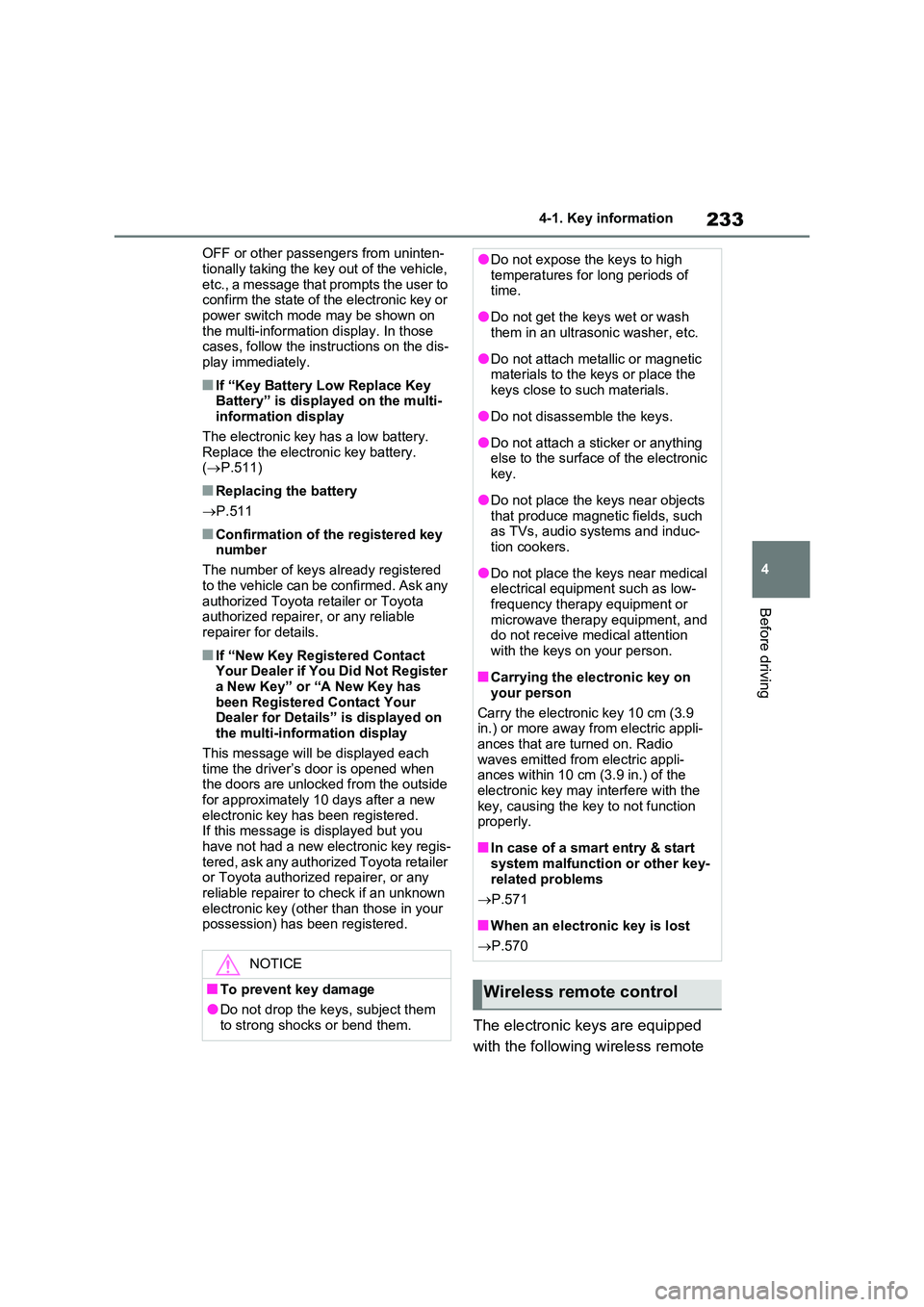
233
4
4-1. Key information
Before driving
OFF or other passengers from uninten-
tionally taking the key out of the vehicle, etc., a message that prompts the user to confirm the state of the electronic key or
power switch mode may be shown on the multi-information display. In those cases, follow the instructions on the dis-
play immediately.
■If “Key Battery Low Replace Key Battery” is displayed on the multi-information display
The electronic key has a low battery. Replace the electronic key battery. ( P.511)
■Replacing the battery
P.511
■Confirmation of the registered key number
The number of keys already registered
to the vehicle can be confirmed. Ask any authorized Toyota retailer or Toyota authorized repairer, or any reliable
repairer for details.
■If “New Key Registered Contact Your Dealer if You Did Not Register a New Key” or “A New Key has
been Registered Contact Your Dealer for Details” is displayed on the multi-information display
This message will be displayed each time the driver’s door is opened when the doors are unlocked from the outside
for approximately 10 days after a new electronic key has been registered. If this message is displayed but you
have not had a new electronic key regis- tered, ask any authorized Toyota retailer or Toyota authorized repairer, or any
reliable repairer to check if an unknown electronic key (other than those in your possession) has been registered.
The electronic keys are equipped
with the following wireless remote
NOTICE
■To prevent key damage
●Do not drop the keys, subject them to strong shocks or bend them.
●Do not expose the keys to high temperatures for long periods of time.
●Do not get the keys wet or wash them in an ultrasonic washer, etc.
●Do not attach metallic or magnetic materials to the keys or place the
keys close to such materials.
●Do not disassemble the keys.
●Do not attach a sticker or anything else to the surface of the electronic
key.
●Do not place the keys near objects
that produce magnetic fields, such as TVs, audio systems and induc-tion cookers.
●Do not place the keys near medical electrical equipment such as low-
frequency therapy equipment or microwave therapy equipment, and do not receive medical attention
with the keys on your person.
■Carrying the electronic key on
your person
Carry the electronic key 10 cm (3.9 in.) or more away from electric appli-
ances that are turned on. Radio waves emitted from electric appli-ances within 10 cm (3.9 in.) of the
electronic key may interfere with the key, causing the key to not function properly.
■In case of a smart entry & start system malfunction or other key-
related problems
P.571
■When an electronic key is lost
P.570
Wireless remote control
Page 238 of 718
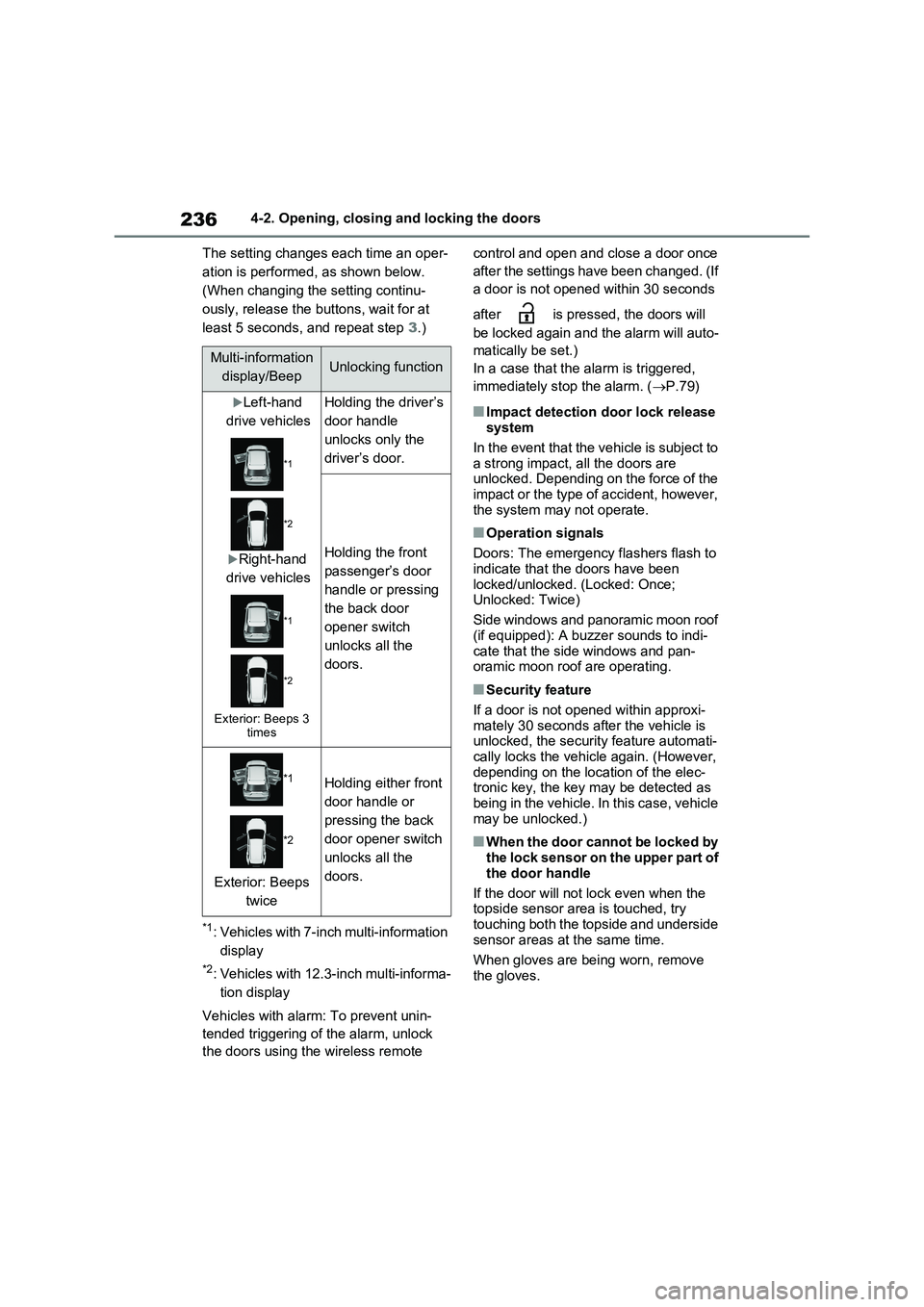
2364-2. Opening, closing and locking the doors
The setting changes each time an oper-
ation is performed, as shown below.
(When changing the setting continu-
ously, release the buttons, wait for at
least 5 seconds, and repeat step 3.)
*1: Vehicles with 7-inch multi-information
display
*2: Vehicles with 12.3-inch multi-informa-
tion display
Vehicles with alarm: To prevent unin-
tended triggering of the alarm, unlock
the doors using the wireless remote control and open and close a door once
after the settings have been changed. (If
a door is not opened within 30 seconds
after is pressed, the doors will
be locked again and the alarm will auto-
matically be set.)
In a case that the alarm is triggered,
immediately stop the alarm. (P.79)
■Impact detection door lock release
system
In the event that the vehicle is subject to
a strong impact, all the doors are
unlocked. Depending on the force of the
impact or the type of accident, however,
the system may not operate.
■Operation signals
Doors: The emergency flashers flash to
indicate that the doors have been
locked/unlocked. (Locked: Once;
Unlocked: Twice)
Side windows and panoramic moon roof
(if equipped): A buzzer sounds to indi-
cate that the side windows and pan-
oramic moon roof are operating.
■Security feature
If a door is not opened within approxi-
mately 30 seconds after the vehicle is
unlocked, the security feature automati-
cally locks the vehicle again. (However,
depending on the location of the elec-
tronic key, the key may be detected as
being in the vehicle. In this case, vehicle
may be unlocked.)
■When the door cannot be locked by
the lock sensor on the upper part of
the door handle
If the door will not lock even when the
topside sensor area is touched, try
touching both the topside and underside
sensor areas at the same time.
When gloves are being worn, remove
the gloves.
Multi-information
display/BeepUnlocking function
Left-hand
drive vehicles
*1
*2
Right-hand
drive vehicles
*1
*2
Exterior: Beeps 3
times
Holding the driver’s
door handle
unlocks only the
driver’s door.
Holding the front
passenger’s door
handle or pressing
the back door
opener switch
unlocks all the
doors.
*1
*2
Exterior: Beeps
twice
Holding either front
door handle or
pressing the back
door opener switch
unlocks all the
doors.
Page 239 of 718
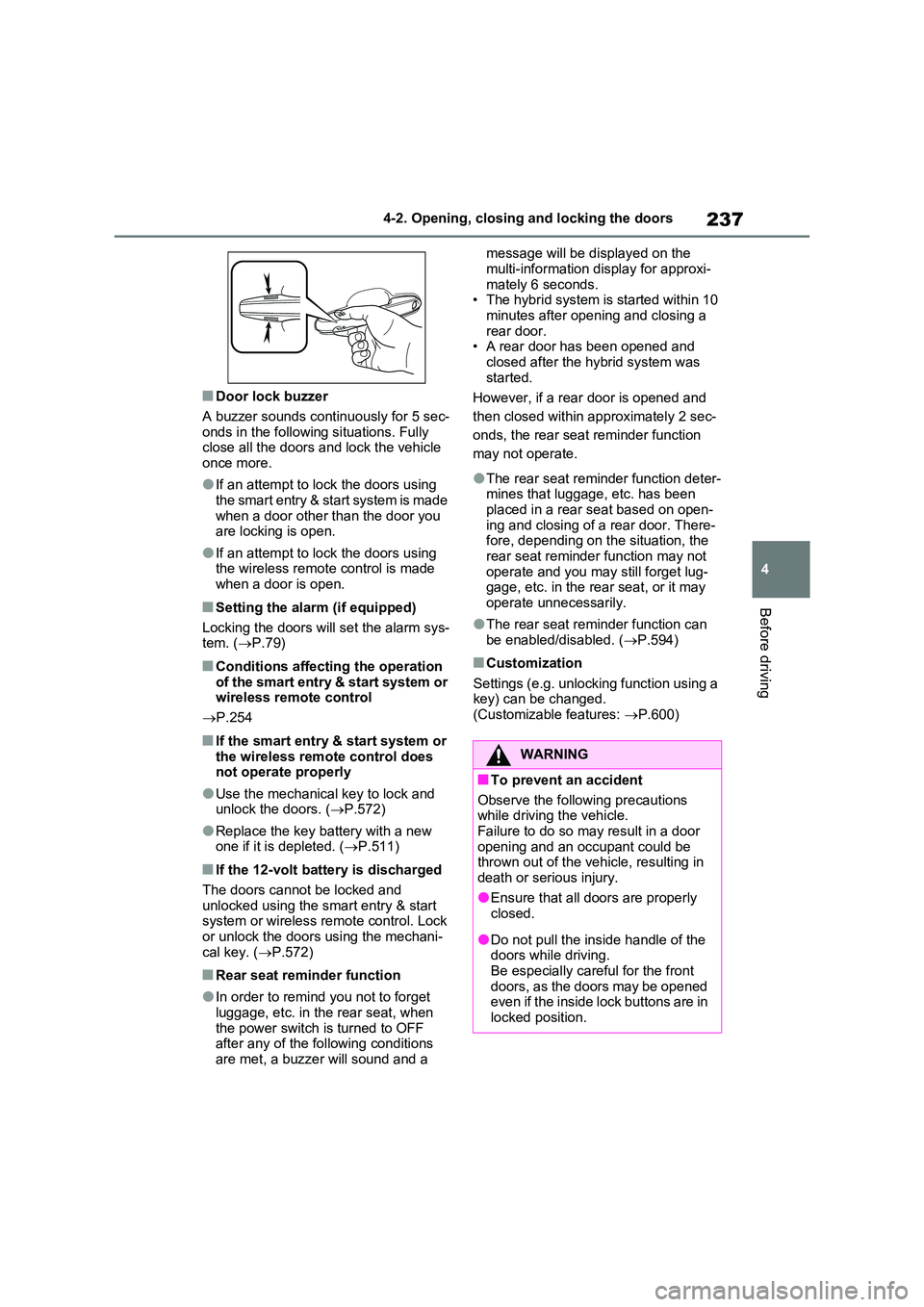
237
4
4-2. Opening, closing and locking the doors
Before driving
■Door lock buzzer
A buzzer sounds continuously for 5 sec- onds in the following situations. Fully close all the doors and lock the vehicle
once more.
●If an attempt to lock the doors using
the smart entry & start system is made when a door other than the door you are locking is open.
●If an attempt to lock the doors using the wireless remote control is made
when a door is open.
■Setting the alarm (if equipped)
Locking the doors will set the alarm sys- tem. ( P.79)
■Conditions affecting the operation
of the smart entry & start system or wireless remote control
P.254
■If the smart entry & start system or
the wireless remote control does not operate properly
●Use the mechanical key to lock and unlock the doors. ( P.572)
●Replace the key battery with a new one if it is depleted. ( P.511)
■If the 12-volt battery is discharged
The doors cannot be locked and
unlocked using the smart entry & start system or wireless remote control. Lock or unlock the doors using the mechani-
cal key. ( P.572)
■Rear seat reminder function
●In order to remind you not to forget
luggage, etc. in the rear seat, when the power switch is turned to OFF after any of the following conditions
are met, a buzzer will sound and a
message will be displayed on the
multi-information display for approxi- mately 6 seconds.• The hybrid system is started within 10
minutes after opening and closing a rear door.• A rear door has been opened and
closed after the hybrid system was started.
However, if a rear door is opened and
then closed within approximately 2 sec-
onds, the rear seat reminder function
may not operate.
●The rear seat reminder function deter- mines that luggage, etc. has been placed in a rear seat based on open-
ing and closing of a rear door. There- fore, depending on the situation, the rear seat reminder function may not
operate and you may still forget lug- gage, etc. in the rear seat, or it may operate unnecessarily.
●The rear seat reminder function can be enabled/disabled. ( P.594)
■Customization
Settings (e.g. unlocking function using a key) can be changed.(Customizable features: P.600)
WARNING
■To prevent an accident
Observe the following precautions while driving the vehicle.
Failure to do so may result in a door opening and an occupant could be thrown out of the vehicle, resulting in
death or serious injury.
●Ensure that all doors are properly closed.
●Do not pull the inside handle of the doors while driving.
Be especially careful for the front doors, as the doors may be opened even if the inside lock buttons are in
locked position.
Page 240 of 718
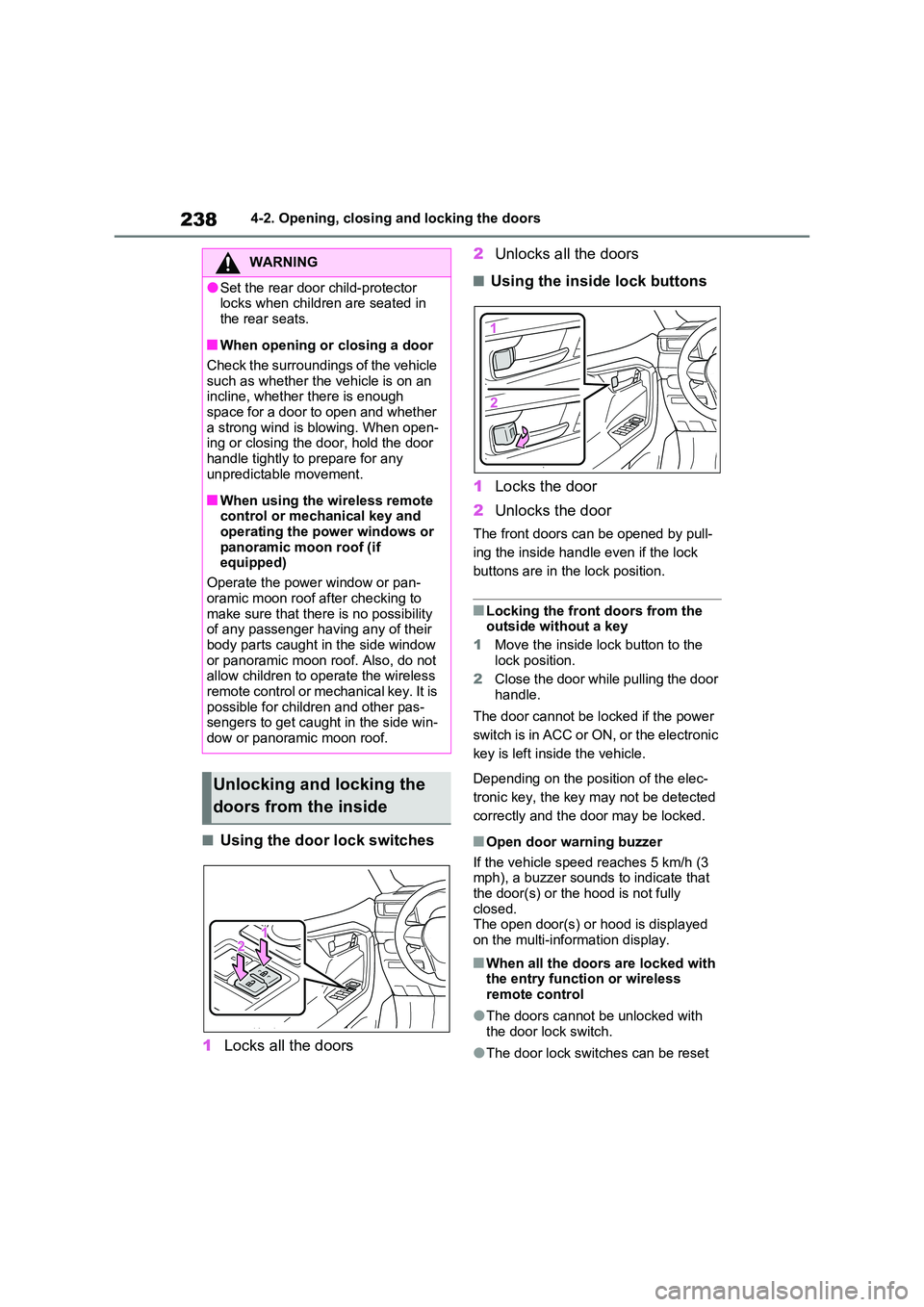
2384-2. Opening, closing and locking the doors
■Using the door lock switches
1 Locks all the doors
2 Unlocks all the doors
■Using the inside lock buttons
1 Locks the door
2 Unlocks the door
The front doors can be opened by pull-
ing the inside handle even if the lock
buttons are in the lock position.
■Locking the front doors from the outside without a key
1 Move the inside lock button to the lock position.
2 Close the door while pulling the door
handle.
The door cannot be locked if the power
switch is in ACC or ON, or the electronic
key is left inside the vehicle.
Depending on the position of the elec-
tronic key, the key may not be detected
correctly and the door may be locked.
■Open door warning buzzer
If the vehicle speed reaches 5 km/h (3 mph), a buzzer sounds to indicate that the door(s) or the hood is not fully
closed. The open door(s) or hood is displayed
on the multi-information display.
■When all the doors are locked with the entry function or wireless remote control
●The doors cannot be unlocked with the door lock switch.
●The door lock switches can be reset
WARNING
●Set the rear door child-protector locks when children are seated in
the rear seats.
■When opening or closing a door
Check the surroundings of the vehicle such as whether the vehicle is on an incline, whether there is enough
space for a door to open and whether a strong wind is blowing. When open-ing or closing the door, hold the door
handle tightly to prepare for any unpredictable movement.
■When using the wireless remote control or mechanical key and operating the power windows or
panoramic moon roof (if equipped)
Operate the power window or pan-
oramic moon roof after checking to make sure that there is no possibility of any passenger having any of their
body parts caught in the side window or panoramic moon roof. Also, do not allow children to operate the wireless
remote control or mechanical key. It is possible for children and other pas-sengers to get caught in the side win-
dow or panoramic moon roof.
Unlocking and locking the
doors from the inside
Page 249 of 718
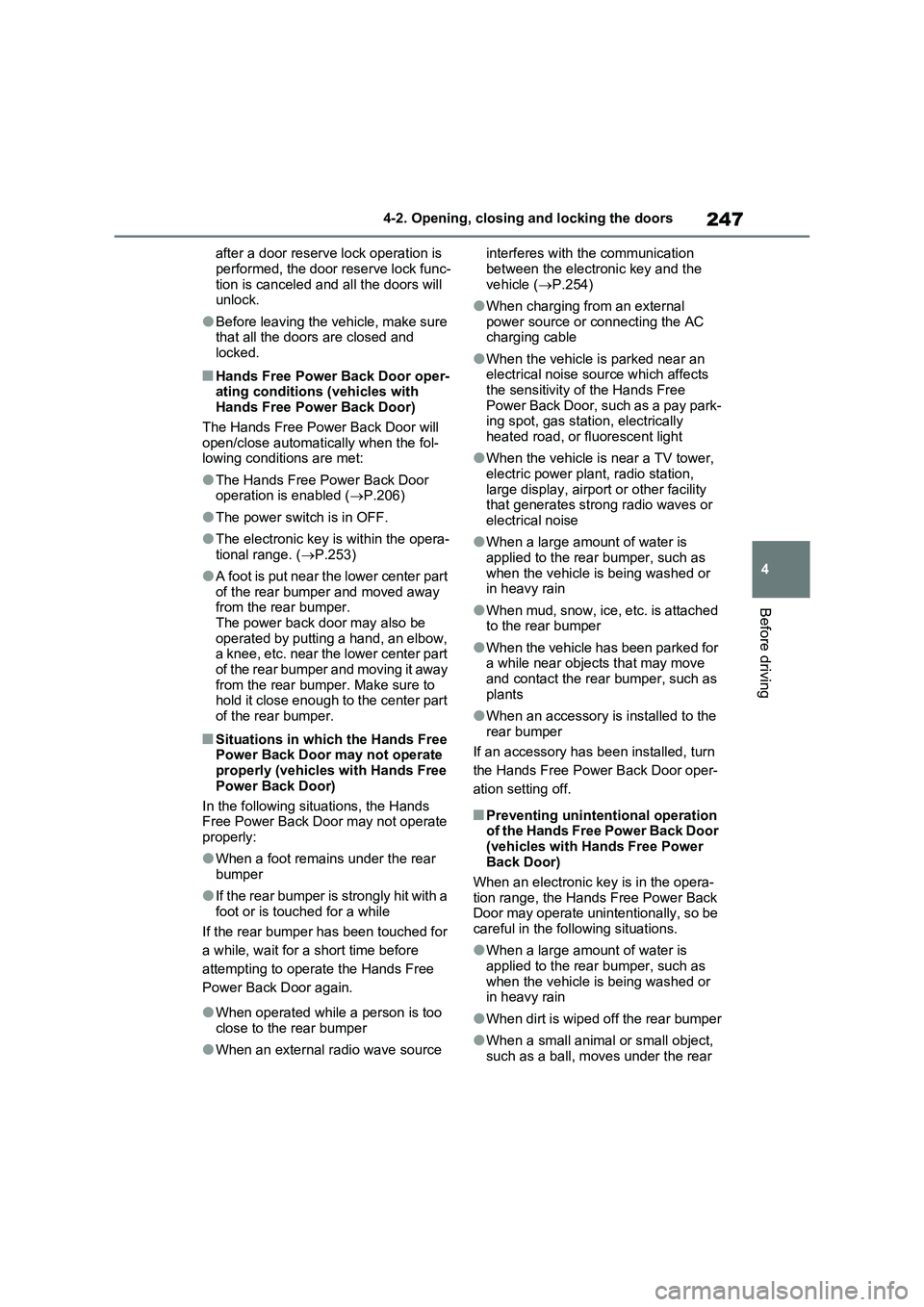
247
4 4-2. Opening, closing and locking the doors
Before driving
after a door reserve lock operation is
performed, the door reserve lock func-
tion is canceled and all the doors will
unlock.
●Before leaving the vehicle, make sure
that all the doors are closed and
locked.
■Hands Free Power Back Door oper-
ating conditions (vehicles with
Hands Free Power Back Door)
The Hands Free Power Back Door will
open/close automatically when the fol-
lowing conditions are met:
●The Hands Free Power Back Door
operation is enabled (P.206)
●The power switch is in OFF.
●The electronic key is within the opera-
tional range. (P.253)
●A foot is put near the lower center part
of the rear bumper and moved away
from the rear bumper.
The power back door may also be
operated by putting a hand, an elbow,
a knee, etc. near the lower center part
of the rear bumper and moving it away
from the rear bumper. Make sure to
hold it close enough to the center part
of the rear bumper.
■Situations in which the Hands Free
Power Back Door may not operate
properly (vehicles with Hands Free
Power Back Door)
In the following situations, the Hands
Free Power Back Door may not operate
properly:
●When a foot remains under the rear
bumper
●If the rear bumper is strongly hit with a
foot or is touched for a while
If the rear bumper has been touched for
a while, wait for a short time before
attempting to operate the Hands Free
Power Back Door again.
●When operated while a person is too
close to the rear bumper
●When an external radio wave source interferes with the communication
between the electronic key and the
vehicle (P.254)
●When charging from an external
power source or connecting the AC
charging cable
●When the vehicle is parked near an
electrical noise source which affects
the sensitivity of the Hands Free
Power Back Door, such as a pay park-
ing spot, gas station, electrically
heated road, or fluorescent light
●When the vehicle is near a TV tower,
electric power plant, radio station,
large display, airport or other facility
that generates strong radio waves or
electrical noise
●When a large amount of water is
applied to the rear bumper, such as
when the vehicle is being washed or
in heavy rain
●When mud, snow, ice, etc. is attached
to the rear bumper
●When the vehicle has been parked for
a while near objects that may move
and contact the rear bumper, such as
plants
●When an accessory is installed to the
rear bumper
If an accessory has been installed, turn
the Hands Free Power Back Door oper-
ation setting off.
■Preventing unintentional operation
of the Hands Free Power Back Door
(vehicles with Hands Free Power
Back Door)
When an electronic key is in the opera-
tion range, the Hands Free Power Back
Door may operate unintentionally, so be
careful in the following situations.
●When a large amount of water is
applied to the rear bumper, such as
when the vehicle is being washed or
in heavy rain
●When dirt is wiped off the rear bumper
●When a small animal or small object,
such as a ball, moves under the rear
Page 250 of 718
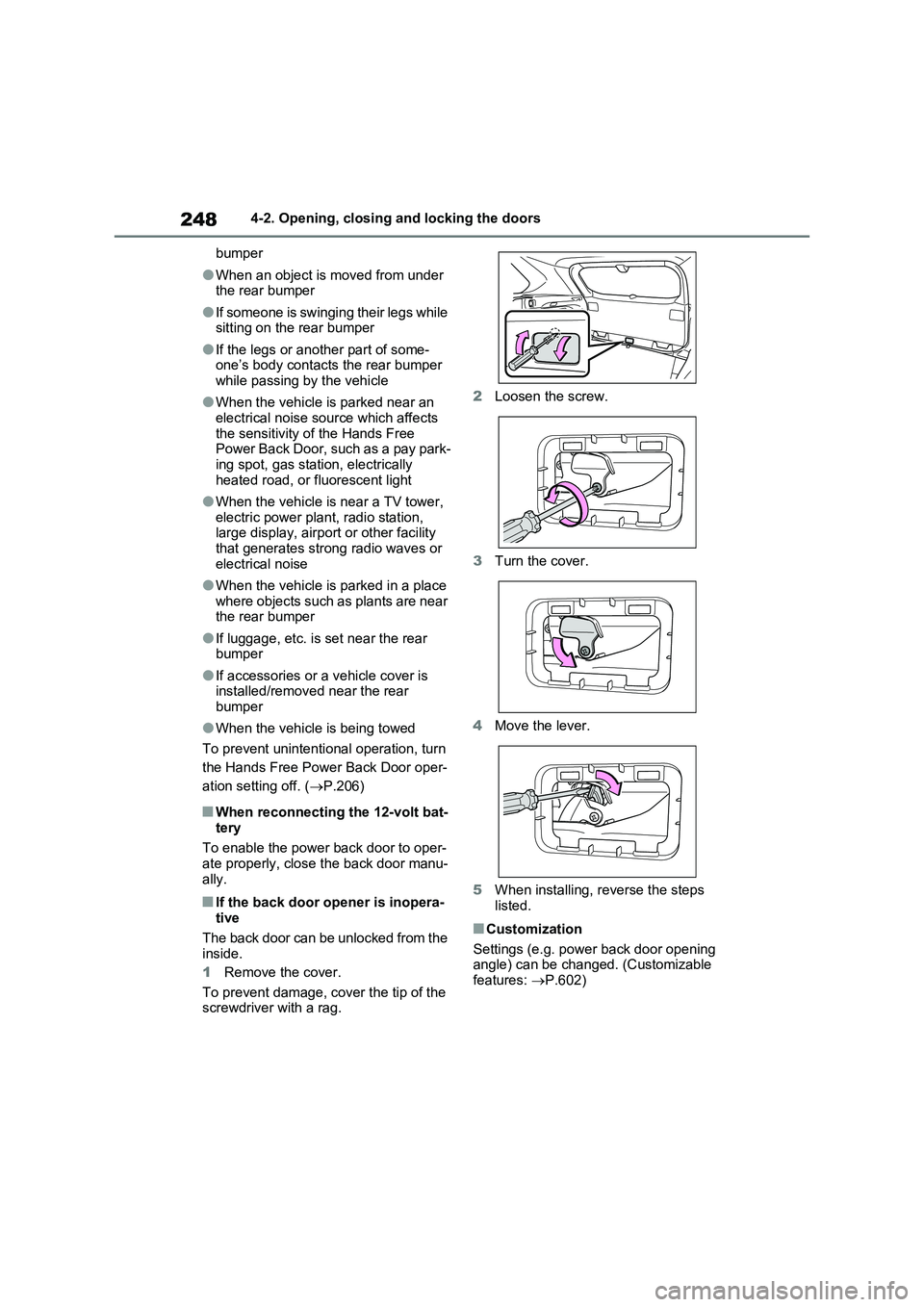
2484-2. Opening, closing and locking the doors
bumper
●When an object is moved from under
the rear bumper
●If someone is swinging their legs while
sitting on the rear bumper
●If the legs or another part of some-
one’s body contacts the rear bumper
while passing by the vehicle
●When the vehicle is parked near an
electrical noise source which affects
the sensitivity of the Hands Free
Power Back Door, such as a pay park-
ing spot, gas station, electrically
heated road, or fluorescent light
●When the vehicle is near a TV tower,
electric power plant, radio station,
large display, airport or other facility
that generates strong radio waves or
electrical noise
●When the vehicle is parked in a place
where objects such as plants are near
the rear bumper
●If luggage, etc. is set near the rear
bumper
●If accessories or a vehicle cover is
installed/removed near the rear
bumper
●When the vehicle is being towed
To prevent unintentional operation, turn
the Hands Free Power Back Door oper-
ation setting off. (P.206)
■When reconnecting the 12-volt bat-
tery
To enable the power back door to oper-
ate properly, close the back door manu-
ally.
■If the back door opener is inopera-
tive
The back door can be unlocked from the
inside.
1Remove the cover.
To prevent damage, cover the tip of the
screwdriver with a rag.2Loosen the screw.
3Turn the cover.
4Move the lever.
5When installing, reverse the steps
listed.
■Customization
Settings (e.g. power back door opening
angle) can be changed. (Customizable
features: P.602)
Page 253 of 718
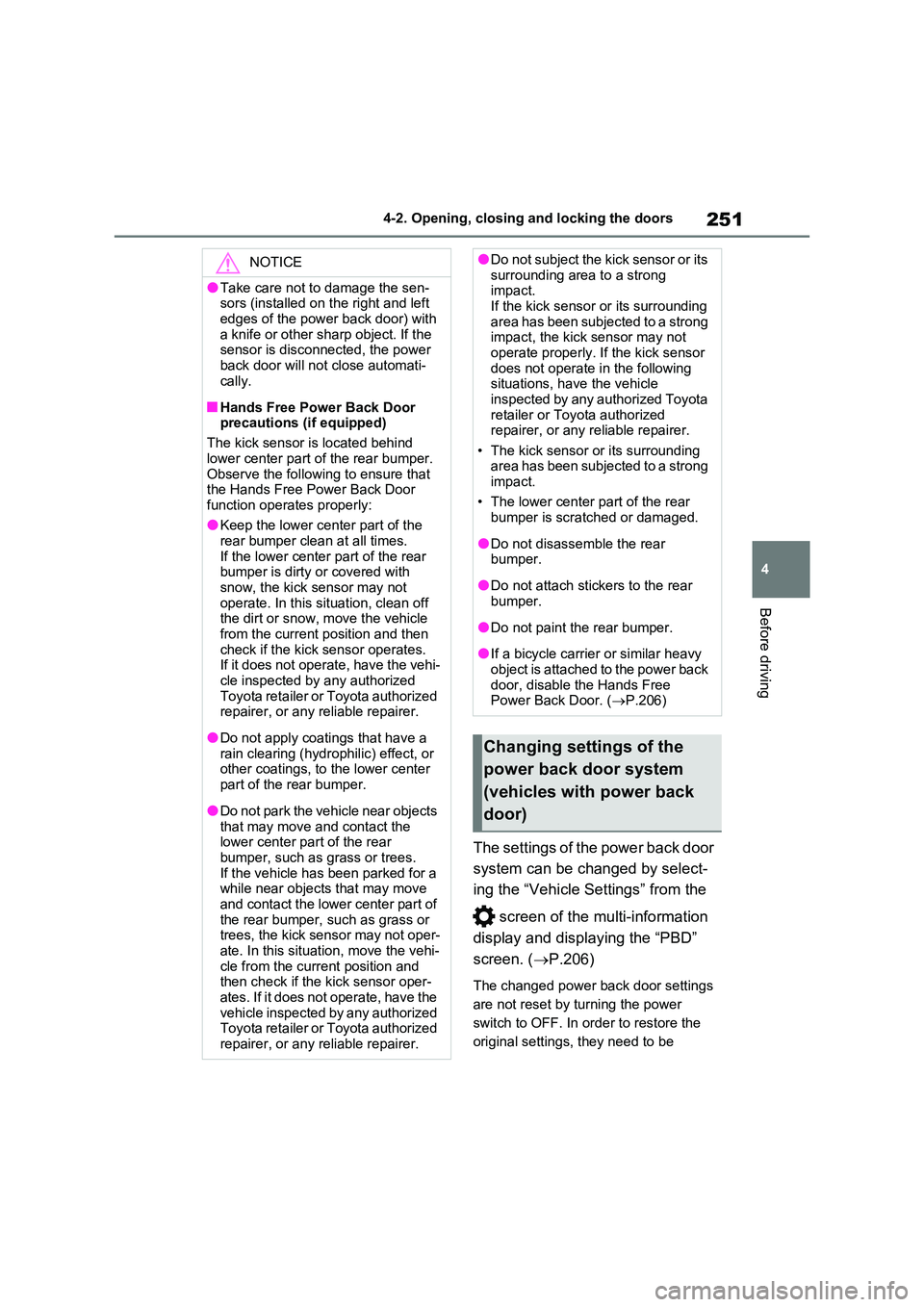
251
4
4-2. Opening, closing and locking the doors
Before driving
The settings of the power back door
system can be changed by select-
ing the “Vehicle Settings” from the
screen of the multi-information
display and displaying the “PBD”
screen. ( P.206)
The changed power back door settings
are not reset by turning the power
switch to OFF. In order to restore the
original settings, they need to be
NOTICE
●Take care not to damage the sen- sors (installed on the right and left
edges of the power back door) with a knife or other sharp object. If the sensor is disconnected, the power
back door will not close automati- cally.
■Hands Free Power Back Door precautions (if equipped)
The kick sensor is located behind
lower center part of the rear bumper. Observe the following to ensure that the Hands Free Power Back Door
function operates properly:
●Keep the lower center part of the rear bumper clean at all times.
If the lower center part of the rear bumper is dirty or covered with snow, the kick sensor may not
operate. In this situation, clean off the dirt or snow, move the vehicle from the current position and then
check if the kick sensor operates. If it does not operate, have the vehi-cle inspected by any authorized
Toyota retailer or Toyota authorized repairer, or any reliable repairer.
●Do not apply coatings that have a rain clearing (hydrophilic) effect, or other coatings, to the lower center
part of the rear bumper.
●Do not park the vehicle near objects
that may move and contact the lower center part of the rear bumper, such as grass or trees.
If the vehicle has been parked for a while near objects that may move and contact the lower center part of
the rear bumper, such as grass or trees, the kick sensor may not oper-ate. In this situation, move the vehi-
cle from the current position and then check if the kick sensor oper-ates. If it does not operate, have the
vehicle inspected by any authorized Toyota retailer or Toyota authorized repairer, or any reliable repairer.
●Do not subject the kick sensor or its surrounding area to a strong impact.
If the kick sensor or its surrounding area has been subjected to a strong impact, the kick sensor may not
operate properly. If the kick sensor does not operate in the following situations, have the vehicle
inspected by any authorized Toyota retailer or Toyota authorized repairer, or any reliable repairer.
• The kick sensor or its surrounding area has been subjected to a strong impact.
• The lower center part of the rear bumper is scratched or damaged.
●Do not disassemble the rear bumper.
●Do not attach stickers to the rear bumper.
●Do not paint the rear bumper.
●If a bicycle carrier or similar heavy
object is attached to the power back door, disable the Hands Free Power Back Door. ( P.206)
Changing settings of the
power back door system
(vehicles with power back
door)